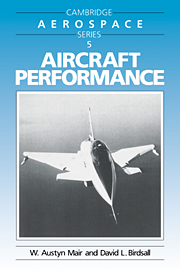Book contents
- Frontmatter
- Contents
- Preface
- Introduction
- 1 Aerodynamic foundations
- 2 Basic flight theory
- 3 Drag equations
- 4 Climbing performance
- 5 Power plants
- 6 Take-off and landing performance
- 7 Fuel consumption, range and endurance
- 8 Turning performance
- 9 Vectored thrust
- 10 Transonic and supersonic flight
- Appendixes
- References
- Index
9 - Vectored thrust
Published online by Cambridge University Press: 02 December 2009
- Frontmatter
- Contents
- Preface
- Introduction
- 1 Aerodynamic foundations
- 2 Basic flight theory
- 3 Drag equations
- 4 Climbing performance
- 5 Power plants
- 6 Take-off and landing performance
- 7 Fuel consumption, range and endurance
- 8 Turning performance
- 9 Vectored thrust
- 10 Transonic and supersonic flight
- Appendixes
- References
- Index
Summary
An aircraft with vectored thrust is defined here as one in which the pilot is able to vary the direction of the engine thrust over a wide range, usually at least 90°. The main advantage of this facility is that if the maximum available thrust is greater than the weight, the aircraft is able to take-off and land vertically, i.e. with zero ground run. If the thrust is large but still less than the take-off weight it may be possible to use thrust vectoring to give a substantial reduction in the distance required for take-off and in this case the landing weight may be less than the available thrust so that a vertical landing may be possible. Aircraft with vectored thrust are commonly known as V/STOL aircraft because they are capable of vertical or short take-off and landing.
V/STOL aircraft have been designed with several distinct configurations, the best known being that used in the Harrier as shown in Figure 9.1 and described by Fozard (1986), where the propulsive jets can be deflected downward by movable nozzles. Other forms have been reviewed by Poisson-Quinton (1968) and include the tilt rotor, where lifting rotors of the kind used in helicopters are tilted forward to operate like normal propellers in forward flight, and the tilt wing where the rotor axes remain fixed in the wing and the whole wing–rotor assembly is rotated relative to the fuselage. An example of a tilt-rotor aircraft is the Bell Textron Osprey shown in Figure 9.2.
- Type
- Chapter
- Information
- Aircraft Performance , pp. 237 - 251Publisher: Cambridge University PressPrint publication year: 1992



